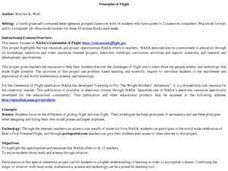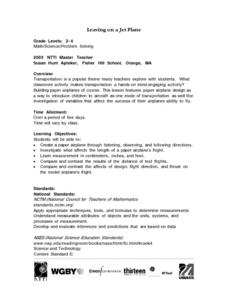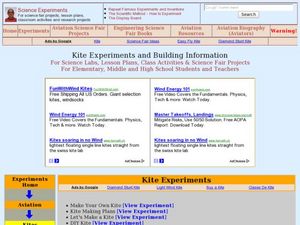Curated OER
Principles of Flight: Flying Paper Airplanes
Students investigate ways to enhance an object's flying ability. In this model construction instructional activity, students construct two paper airplanes, one of which is twice as big as the first. Students compare and...
LABScI
Catapult: Flight of the Marshmallows
Watch your marshmallows fly. The engaging STEM activity has groups create a catapult to launch marshmallows. After testing their prototypes, they consider improvements and redesign their catapults.
Curated OER
Flying the Friendly Skies
Students discover the power of wind by flying a glider. In this weather lesson, students describe their thoughts on wind and practice using weather related vocabulary. Students construct model gliders in class and attempt to...
Curated OER
Principles Of Flight: Wings That Spin
Students discover how flight is possible. In this physics lesson, students investigate the properties of a blimp and gyro-copter, comparing rotating wings and fixed wings of aircraft. Students create their own model aircraft...
Curated OER
Flying and Migration
Students listen to a read aloud of an excerpt of Janet Eaton Givens, Just Two Wings, before reviewing what birds use to fly, and the meaning of migration. They use hot lists of websites to research the Internet for information about the...
Curated OER
Discovering Flight
Students discuss what wind can do such as cause a ball to roll, a book to open, water to move. They observe in the book, "Up, Up and Away!: the Sciene of Flight" things that fly and begin brainstoring things on paper that can fly. They...
Curated OER
The Airplane
Students demonstrate the Bernoulli Principle, review the influences that affected the Wright Brothers, and make and modify paper airplanes. This amazing lesson plan has an excellent structure, and very clear plans for the students to...
Curated OER
Gliders
Students design and build a small glider. They see how the flight of a bird is similar to the flight of a sailplane. They explain how birds get their thrust and how they control their direction of flight.
Curated OER
The Wright Stuff
In this lesson, students design an exhibition on the history of aviation for a science museum. For homework, they write short stories envisioning the future of flight in the year 2014.
Curated OER
Exploring Aerodynamics
Students explore aerodynamics. In this aerodynamics lesson, students study the flight patterns of three paper airplanes and discover the underlying principles of aerodynamics. Resources and grade level modifications are present.
Curated OER
Dayna Lykins, Leanna Prater
Fourth graders compare and contrast gliding flight and true flight. They investigate the basic principles of aeronautics. The class participates in activities to observe lift and the effect of air. Students design and fly their own...
Curated OER
PHYSICS OF FLIGHT
Ninth graders study the basic principles of flight, including the Bernoulli Principle and Newton's Laws. They construct and study model aircraft
Curated OER
Soar Into Spring With Kites!
The kite has an amazing history! It has been used for thousands of years, has led to many scientific disoveries, and has made some people very famous. Just ask Ben Franklin! This terrific instructional activity offers many...
Curated OER
Come Fly With Me...Aviation
Students conduct internet research on aviation and pioneer aviators. They create an alphabet book r with flight related terms, write a short biography of a pioneer aviator and take part in a paper plane flying contest.
Curated OER
Leaving on A Jet Plane
Students create an airplane by listening to directions. They also to measure the pieces for the airplane and compare and contrast their test flights.
Curated OER
100 Years of Flight
Students investigate Bernoulli's principle of air pressure and how it
relates to the lift of an airplane. Students identify various Aeronautical vocabulary terms. Students construct a paper glider and experiment with the control surfaces...
Curated OER
Testing and Refining Aircraft Design
Students design and make a flying device. They work in small groups to brainstorm ideas for the design of their device. They choose an idea or combination of ideas to use for their design and create a sketch of their design. The students...
Curated OER
Kite Experiments and Building Information
Students build their own kite following certain procedures. In this physics instructional activity, students explain the aerodynamics concepts involved in flying kites. They trace the development of aviation.
Curated OER
Power Point Lesson Plan
Students create a multimedia animal research presentation based on the include criteria for both information and sideshow format. They follow directions on slide set-up from creating a slide to transitions and musical insertion.
Curated OER
Fossils Footprints Across Time
Students examine fossils to understand how they are formed and how they give information about geological history. In this fossil lesson, students research and write about fossils and make models of different fossil types.The PDF...
Curated OER
Balloons: Math with the Montgolfier Balloon
Students discover the history of hot air balloons by watching one ascent. In this physics lesson, students utilize a Montgolfier Hot Air Balloon from an earlier lesson and record the temperature, rate of ascent and the volume....
Curated OER
Sled Kite Proportions
Young scholars build sled kites. in this kite building lesson, students must read directions for kite building and enlarge the proportions of the given kite pattern. Young scholars focus on the angles and line of symmetry in their...
Curated OER
Flying High in Math
Seventh graders study how real airplanes fly and then they construct models of paper airplanes using design resources for the Internet and their own design. They use meaurement and caluculations in order to help them construct their...
Curated OER
Flying High With Hot Air Balloons!
Sixth graders demonstrate an understanding of a narrative story by listening, speaking, reading and writing activities. They create two visual products that reflect the understanding of events, vocabulary, and characters.























